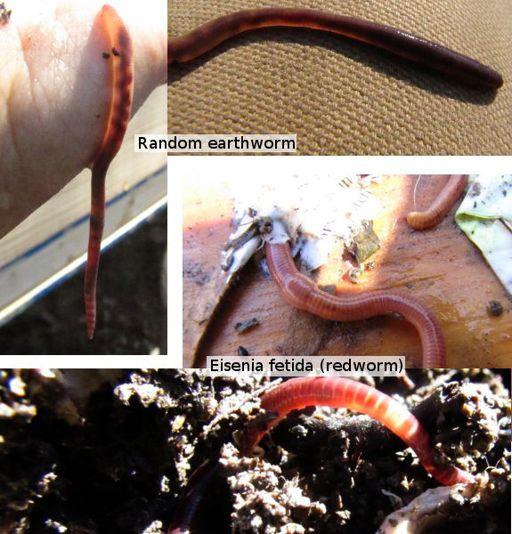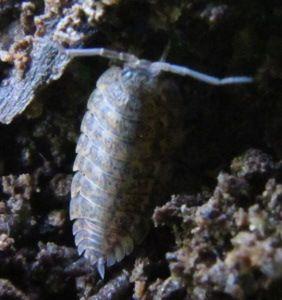Naturally Bug-Free (4 page)
Read Naturally Bug-Free Online
Authors: Anna Hess


Earthworms are the classic soil-improving invertebrates. Above, I've pictured redworms that you might keep in a worm-composting system, as well as the earthworms you're more likely to find in your garden soil.
Nearly every invertebrate you find in the soil is a good bug with a job to do. Some (like earthworms and woodlice) digest organic matter and help build humus, while others (like centipedes and spiders) are busy eating the smaller soil organisms. The combination of critters is essential for preventing the buildup of dead material on top of the soil and for releasing nutrients that plants use to grow.

Woodlice are decomposers, but gardeners often incorrectly blame them for the work of slugs.
On the other hand, a few soil critters are neutral or are actively bad for your garden. Ants can help disperse seeds of native plants, but they also protect aphids that suck the juices out of your trees and vegetables. Some grubs turn into Japanese beetles or June bugs (
Cotinus nitida
), the first of which eat leaves of many fruit plants and the second of which enjoy eating the fruits themselves. And then there are the cutworms I mentioned in the last chapter—plump caterpillars who nibble the tops off seedlings.
 A crawdad chimney is a sign that a crayfish is living in the groundwater under your garden.
A crawdad chimney is a sign that a crayfish is living in the groundwater under your garden.
But even problematic soil inhabitants tend to loosen the soil and to carry organic matter deep beneath the surface. Earthworms—everyone's favorite denizen of the dirt—can eat their way ten feet deep, adding nutritious calcium to everything that passes through their gut. Ants are pretty useful in this respect too since they carry food down into their nests, resulting in pockets of rich soil, while bringing mineral-rich subsoil to the surface. In wet areas (like my garden), crayfish do a similar job of nutrient movement.
Meanwhile, other organisms like those troublesome beetle grubs I mentioned previously fluff up soil and deposit nutrients in the form of their feces as they travel up and down through the earth. Ground-nesting bees and wasps such as sweat bees (
Halictus
sp.), miner bees (
Andrena
sp.), and various digger wasps all excavate burrows for their larvae to live in, while dung beetles fill their underground dens with rich balls of excrement. Of course, the bees, wasps, and dung beetles are all unequivocally good bugs since the first two pollinate your garden and often eat bad bugs, while the last help cycle nutrients through the ecosystem.
If you'd like a closer look at the critters who live beneath the surface, I recommend
Life in the Soil
, by James B. Nardi. On the other hand, if you just want to keep your garden healthy, it's pretty simple to promote soil life. Most soil organisms need damp soil, so topping your garden off with mulch is a great way to keep the critters active during hot summers. The use of cover crops and compost is also recommended to jumpstart your soil ecosystem by providing microorganisms and invertebrates with a buffet—think of compost and decomposing cover crops like bird feeders for the tiny inhabitants of your dirt.
What shouldn't you do to your soil? While tilling can break some pest-bug cycles, the practice also demolishes populations of beneficial soil organisms like earthworms. Chemical fertilizers have a similar effect, as does leaving the earth bare of plants or mulch so that erosion and heat can remove nutrients from the soil.
Why not nurture an organic, no-till garden and let your soil workers do the job of tilling and fertilizing for you? (I explain how to begin and maintain a no-till garden in
The Weekend Homesteader
.) Then you'll have a healthier garden and tastier vegetables...and won't have to work as hard!
Pollinators

Even beetles can be pollinators, as I discovered when I went out to check on the first spring flowers in the woods.
While soil workers may be the most essential invertebrates in your garden, the flashiest good bugs are pollinators. Honeybees (
Apis
sp.) are the poster children of pollination since they produce delicious honey as well as moving pollen from flower to flower, but you can have a very well-pollinated garden without building an apiary. In fact, some scientists believe that an overabundance of non-native honeybees causes declines in native-pollinator populations.
 Some insects you are probably already familiar with, like bumblebees, sweat bees (shown here), and carpenter bees, are high-quality pollinators.
Some insects you are probably already familiar with, like bumblebees, sweat bees (shown here), and carpenter bees, are high-quality pollinators.
If you want to identify the insects visiting your flowers, I highly recommend the Xerces Society's book
Attracting Native Pollinators
. However, you don't really need to get so fancy as to figure out the species of each little insect on your apple blossoms in the spring. Nearly any insect on a flower is looking for pollen or nectar, and the insect is likely to accidentally move pollen to the next flower in the process. Your goal should simply be to promote a diverse array of different pollinators in the garden throughout the year.
How will you know if your pollinator population
isn't
up to par? If you find cucumbers fat at one end and skinny at the other, baby summer squash that are rotting at the blossom end, blackberries with only a few plump lobes, or lop-sided apples with a big side and a little side, your garden isn't seeing proper pollination. In some cases, inadequate pollination can be due to weather, but if you notice problems, your first step should be to ensure you're providing the proper habitat for wild pollen movers. (There's not much you can do about a cold spring.)
 Allowing clover and other weeds to grow in your lawn will keep the bees happy.
Allowing clover and other weeds to grow in your lawn will keep the bees happy.
Attracting native pollinators can be nearly as simple as keeping your soil invertebrates happy. First, make sure you have wild or cultivated flowers blooming for as much of the year as possible, and remember that tiny bees may fly only 600 feet or less each day in search of food. The Xerces Society recommends big patches of flowers at least three feet in diameter so they're easy for insects to see during their aerial commute, with smaller rows of flowers tempting the pollinators to continue their explorations out into your garden. The goal is to help a healthy population of pollinators take up residence on your homestead so they're raring to go when your fruit trees bloom in the spring and your cucumber flowers unfurl in the summer, needing their services.
Bloom times of good plants for pollinators
| Spring | Summer | Fall |
|
|
|
